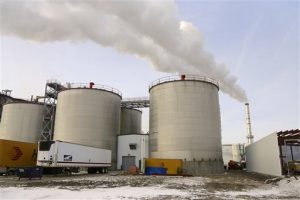Steve Bull's Blog, page 1368
May 8, 2017
Facebook Deletes Tens Of Thousands Of Accounts Ahead Of UK General Election
Ahead of the British general election on June 8, Facebook has deleted tens of thousands of accounts in Britain in its ongoing battle with “fake news” the AP reports. The campaign is part of Facebook’s evolving response to accusations the group was responsible for influencing the US presidential election, through the spread of fake news stories and “filter bubbles”.
“People want to see accurate information on Facebook and so do we. That is why we are doing everything we can to tackle the problem of false news,” said Simon Milner, Facebook’s director of policy for the UK. “To help people spot false news, we are showing tips to everyone . . . on how to identify if something they see is false.”
Simon Milner, the tech firm’s U.K. director of policy, says the platform wants to get to the “root of the problem” and is working with outside organizations to fact check and analyze content around the election. Milner added that Facebook is “doing everything we can to tackle the problem of false news.”
Additionally, on Monday, the social announced a national print advertising campaign in the UK to “educate the British public” about fake news, as part of a concerted global effort to crack down on the false information epidemic it has seen on its platform. The ads suggest that readers should be “skeptical of headlines,” and to “look closely at the URL.” The company says it has made improvements to help them detect fake news accounts more effectively.
The social network’s full-page print ads will appear in four UK newspapers on Monday, including the Telegraph, Times, Metro and Guardian, reproducing the same 10 tips to spot fake news that it launched on Facebook itself last month the FT adds. The UK campaign follows similar newspaper ads in Germany and France last month ahead of their elections, in newspapers including Bild, Süddeutsche Zeitung, Le Monde and Les Échos.
…click on the above link to read the rest of the article…
The Myth of the Rule of Law

Any state, no matter how powerful, cannot not rule solely through the use of brute force. There are too few rulers and too many of us for coercion alone to be an effective means of control. The political class must rely on ideology to achieve popular compliance, masking the iron fist in a velvet glove. Violence is always behind every state action, but the most efficient form of expropriation occurs when the public believes it is in their interest to be extorted.
Mythology is necessary to blunt the violent nature of state power in order to maximize the plunder of property — and, most importantly, provide an aura of legitimacy. The perception of legitimacy “is the only thing distinguishing a tax collector from an extortionist, a police officer from a vigilante, and a soldier from a mercenary. Legitimacy is an illusion in the mind without which the government does not even exist.”1
State authority, and public obedience to it, is manufactured through smokescreens of ideology and deception. These myths sustain the state and offer an illusion of legitimacy, where orders, no matter how immoral or horrific, are followed because they are seen as emanating from a just authority. The state cannot implement violence against everyone everywhere and overwhelm the host, so the battle is waged against the hearts and minds of the public. Fear is exploited, language is distorted, and propaganda is spread, while narratives and history are tightly controlled. The gulag of state power, first and foremost, always exists in the mind.
If the mythology of state power is smashed, then the state is exposed for what it is: institutionalized violence, expropriator of the peaceful and productive, and entirely illegitimate.
…click on the above link to read the rest of the article…
May 7, 2017
The Renewable Fuels Con

You can’t just sell gas anymore.
Most people don’t realize it, but what they’re pumping into their car’s tank isn’t actually gasoline, properly speaking. It’s gasoline mixed with ethanol alcohol – the ratio currently set at 10 percent ethanol and 90 percent gas (E10).
“Diesel” often isn’t exactly diesel, either.
The real stuff – the petroleum-based stuff – is mixed with bio-diesel, which is derived (like ethanol) from non-petroleum sources, usually vegetable matter.
The market isn’t demanding this – but the government is.
There is a law called the Renewable Fuel Standard. It requires the “blending” of oceans of corn con ethanol and biodiesel boondoggle into the general fuel supply – ostensibly, to reduce America’s dependence on foreign (and non-renewable) oil.
Like so much that government does, it sounds good – but what it actually doesisn’t so good.
The RFS has raised refining and distribution costs as well as the cost to motorists, who not only pay more for the Uncle-adulterated fuel but also for the fuel systems in their vehicles, which have had to be modified to be compatible with the not-quite-gas (and sort-of diesel) fuels the government is pushing.
These adulterated fuels are also – ironically – less efficient. A gallon of pure gas will take you farther than a gallon of 90 percent gas and 10 percent ethanol because the gallon of gas contains more energy than a gallon of E10.
As is almost reflexively true of everything the government mandates, we get less – and pay more for it.
But that doesn’t mean someone’s not making a buck – as is also usually true when government intervenes in the market.
In addition to the Usual Suspects – the ethanol lobby, for instance – there is a another group of crony capitalists making hay off the RFS mandate. These are the large refiners and chain gas stations, who can leverage – in the lingo of the federal bureaucracy – Renewable Volume Obligation (RVO) credits to gain an unfair competitive advantage over smaller refiners and independent gas stations.
…click on the above link to read the rest of the article…
Oklahoma Governor Signs Anti-Protest Law Imposing Huge Fines on ‘Conspirator’ Organizations
A STATUTE AIMED at suppressing protests against oil and gas pipelines has been signed into law in Oklahoma, as a related bill advances through the state legislature. The two bills are part of a nationwide trend in anti-protest laws meant to significantly increase legal penalties for civil disobedience. The Oklahoma law signed this week is unique, however, in its broad targeting of groups “conspiring” with protesters accused of trespassing. It takes aim at environmental organizations Republicans have blamed for anti-pipeline protests that have become costly for local governments.
The statute Oklahoma governor Mary Fallin approved Wednesday was rushed into immediate effect under a provision that declared the situation “an emergency.” It will dramatically increase penalties against protesters who trespass on property containing a “critical infrastructure facility.”
Under the newly signed trespassing law individuals will face a felony and a minimum $10,000 fine if a court determines they entered property intending to damage, vandalize, deface, “impede or inhibit operations of the facility.” Should the trespasser actually succeed in “tampering” with the infrastructure, they face a $100,000 fine or ten years of imprisonment.
Significantly, the statute also implicates any organization “found to be a conspirator” with the trespasser, threatening collaborator groups with a fine “ten times” that imposed on the intruder — as much as $1 million in cases involving damage.
A section of the law defining “critical infrastructure” includes various types of fossil fuel facilities. Oklahoma is a center of the oil and gas industry and home of the self-styled “Pipeline Crossroads of the World” in Cushing. The state has seen a dramatic increase in earthquakes since the nation’s fracking boom began, as companies began pumping wastewater produced from hydraulic fracturing underground. The Oklahoma Oil and Gas Association is a supporter of the legislation.
…click on the above link to read the rest of the article…
Global Collapse: Children Are Literally Starving To Death In Venezuela And Yemen
 Venezuela and Yemen were both once very prosperous nations, but now parents are literally watching their children starve to death as the economies of both nations continue to utterly collapse. Just like so many here in the United States, most of those living in Venezuela and Yemen would have called you completely crazy if you would have warned them that this was going to happen five years ago. In particular, Venezuela has more proven oil reserves than almost anyone else on the planet, and so to most of their citizens it was unimaginable that things could ever get this bad. But it has happened, and the collapse that has already begun in parts of South America, Africa and the Middle East will soon spread elsewhere.
Venezuela and Yemen were both once very prosperous nations, but now parents are literally watching their children starve to death as the economies of both nations continue to utterly collapse. Just like so many here in the United States, most of those living in Venezuela and Yemen would have called you completely crazy if you would have warned them that this was going to happen five years ago. In particular, Venezuela has more proven oil reserves than almost anyone else on the planet, and so to most of their citizens it was unimaginable that things could ever get this bad. But it has happened, and the collapse that has already begun in parts of South America, Africa and the Middle East will soon spread elsewhere.When I said that children are literally starving to death in Venezuela, I was not exaggerating one bit. The following comes from the Wall Street Journal…
Jean Pierre Planchart, a year old, has the drawn face of an old man and a cry that is little more than a whimper. His ribs show through his skin. He weighs just 11 pounds.
His mother, Maria Planchart, tried to feed him what she could find combing through the trash—scraps of chicken or potato. She finally took him to a hospital in Caracas, where she prays a rice-milk concoction keeps her son alive.
“I watched him sleep and sleep, getting weaker, all the time losing weight,” said Ms. Planchart, 34 years old. “I never thought I’d see Venezuela like this.”
What would you do if that was your child?
At one time Venezuela had the brightest outlook out of all the economies in South America, but now their economy has contracted by a total of 27 percent since 2013, imports of food have fallen 70 percent, and the IMF says that the inflation rate will hit a staggering 720 percent this year.
…click on the above link to read the rest of the article…
After Years’ Long Push, Fracking Has Quietly Arrived in Alaska

Hydraulic fracturing‘s horizontal drilling technique has enabled industry to tap otherwise difficult-to-access oil and gas in shale basins throughout the U.S. and increasingly throughout the world. And now “fracking,” as it’s known, could soon arrive at a new frontier: Alaska.
As Bloomberg reported in March, Paul Basinski, a pioneer of fracking in Texas’ prolific Eagle Ford Shale, has led the push to explore fracking’s potential there, in what’s been dubbed “Project Icewine.” His company, Burgundy Xploration, is working on fracking in Alaska’s North Slope territory alongside the Australia-based company 88 Energy (formerly ).
“The land sits over three underground bands of shale, from 3,000 to 20,000 feet below ground, that are the source rocks for the huge conventional oilfields to the north,” wrote Bloomberg. “The companies’ first well, Icewine 1, confirmed the presence of petroleum in the shale and found a geology that should be conducive to fracking.”
Why the name “Project Icewine”? “Everything we do is about wine,” Basinski told Alaska Public Radio. “That’s why it’s called Icewine. Because it’s cold up here, and I like German ice wine”
Geographical Terrain
A report by DJ Carmichael, an Australian stockbroker firm, notes that the Project Icewine oilfield is located in close proximity to the Trans-Alaska Pipeline System, which flows from northern to southern Alaska and is co-owned by BP, ConocoPhillips, ExxonMobil, and Chevron.
Drone footage, taken in 2016 by a company owned by Alaska Sen. Lisa Murkowski’s campaign manager, Steve Wackowski, shows a fracking test well being drilled for Icewine 1.
According to an Australian Securities Exchange filing, in April of this year, 88 Energy and Burgundy Xploration began pre-drilling procedures for Icewine 2, a second fracking test well. In the filing, which also noted receipt of a Permit to Drill from the Alaska Oil and Gas Conservation Commission, 88 Energy said it expects to begin “stimulation and production testing” in June or July.
…click on the above link to read the rest of the article…
South Korea’s oil trade under threat
In 2010 the China Sign Post blog published an article entitled “Playing with fire. Potential impact of a North Korean threat to South Korean oil refineries”, showing following map:
 Fig 1: Range of North Korea’s missiles in 2010
Fig 1: Range of North Korea’s missiles in 2010
The article ranked the vulnerability of South Korean and Japanese refineries to a North Korean attack, dependent on distance, location and capacity.

Fig 2: Vulnerability ranking of South Korean and Japanese refineries
http://www.chinasignpost.com/2010/11/29/playing-with-fire-potential-impact-of-a-north-korean-threat-to-south-korean-oil-refineries/
The above article was updated in 2013 when tensions were also very high:
“Ballistic missiles with a circular error of probability of several hundred meters such as North Korea’s No-dong would have a good chance of scoring a hit against a refinery, whose processing units, storage tanks, and other infrastructure can occupy an area of multiple square kilometers. An added bonus from Pyongyang’s perspective is that a missile hit on critical parts of a refinery could put the plant out of commission for at least several months.
Based on the latest missile data from Jane’s and other sources, South Korea’s entire refining capacity of approximately 2.8 million bpd lies within range of North Korean Hwasong 6 and 7 and No-dong missiles, while Japan’s 4.7 million bpd of capacity lies fully within the range envelopes of the No-Dong 1 and 2, Musudan, Taepo-dong, and KN-08 missiles.”
http://www.chinasignpost.com/2013/04/14/playing-with-fire-round-2-north-koreas-potential-missile-threat-to-asian-oil-refining-infrastructure/
That was in 2013. Fast forward to March 2017.

Fig 3: North Korean Scud missile drill
10 March 2017
This time, North Korea launched four “extended-range” Scud missiles that are capable of flying up to 620 miles. The map showed all four missiles landing on an arc that stretched down to the Marine Corps Air Station near Iwakuni, Japan. Once again, the North Korean statement doesn’t leave much to the imagination: “Involved in the drill were
Hwasong artillery units of the KPA (Korean People’s Army) Strategic Force tasked to strike the bases of the U.S. imperialist aggressor forces in Japan in contingency.”
https://www.yahoo.com/news/north-korea-practicing-nuclear-war-144440547.html
…click on the above link to read the rest of the article…
Why Study History?
As liberal Democrats for the most part, United States historians have no doubt been having a field day with Donald Trump’s recently reported clueless comments on United States history. The president’s moronic take on the nation’s past was front-page news last Tuesday in liberals’ and academics’ favorite newspaper, The New York Times. Times reporters Peter Baker and Jonah Engel Bromwich told readers about Trump’s historical idiocy, seen in the president’s:
+ Suggestion that Andrew Jackson had been “really angry”about the Civil War, which did not break out until 16 years after his death.
+ Assertion that the Civil War could have been prevented by smart policymakers who should have just gotten together and cut a deal.
+ Apparent belief that the great 19th century Black abolitionist Frederick Douglass is still alive.
+ Apparent surprise at learning that Abraham Lincoln was a Republican.
+ Putting up a golf course plaque marking a Civil War battle that never happened.
The Times quoted Princeton “presidential historian” Julian E. Zelizer, who thinks that “Presidents should have some better sense of the nation’s history as they become part of it.”
Historian Paul Starobin told the Times that “Trump seems almost uniquely ill equipped to process history, whether because of his lack of empathy, his allergy to complexity, or his tendency to keep distant from anything that might carry the whiff of defeat…History is not tidy. Trump likes tidy. He likes slogans. History doesn’t offer any.”
So, yes, Trump is a dummy about American history, too. I could almost hear the sneers and chuckles across the faculty rooms in academic history departments from coast to coast.
United States of Amnesia
Great, but once they’re done laughing at Dunce Cap Donald, the nation’s academic historians might want to reflect on the broader and unsettling historical ignorance that stalks the United States – and their own roles in enabling it.
…click on the above link to read the rest of the article…
America’s Ready Supply of Enemies
The U.S. political process seems to rely on a steady supply of foreign “enemies” to hate, but sometimes politicians overcome hostilities and talk out differences, which remains the hope for the North Korean standoff, says Ann Wright.
Enemies of the United States come and go, but the longer they espouse revolutionary ideals and thus defy the United States, the longer they stay enemies. Eventually, U.S. officials try other strategies, such as engagement, to undermine or win over these adversaries.
North Korean leader Kim Jong Un.
Currently, the U.S. does not recognize/have diplomatic relations with only three countries—two built on revolutionary models that the U.S. doesn’t like, the Islamic Republic of Iran and the communist regime of North Korea — and Bhutan, a remote Asian kingdom in the Himalayan mountains that purposely isolates itself and has diplomatic relations with only India.
I’m on the way to visit a former U.S. enemy but now recognized diplomatically by the U.S.: Cuba. This trip will be my third in 18 months and the second since the U.S. reopened diplomatic relations with Cuba. The Obama administration took the big leap of talking with the “enemy” with its secret discussions with the Cuban government over a period of two years.
While discussions were proceeding, commercial businessmen and journalists provided the political cover for Obama to withstand the withering criticism from those who strongly opposed dealing with the Cuban government that has been in power since the Cuban revolution in 1959. The U.S. broke diplomatic relations with the new Cuban government on Jan. 3, 1961, because of its nationalization of U.S. businesses in Cuba and its alliance with the Soviet Union.
On July 20, 2015, U.S.-Cuban relations were reestablished after 54 years. On March 20, 2016, President Obama visited Cuba, becoming the first U.S. President in 88 years to visit the island.
…click on the above link to read the rest of the article…
The Real Reasons Why Trump Has Flipped On His Campaign Promises

Back in December of 2016 I wrote an article titled ‘Trump Is Exactly Where The Elites Want Him’, which I think was very difficult for a large part of the liberty movement to read and accept. In that article I outlined the future of the Trump presidency; a future dominated by Washington insiders, Goldman Sachs internationalists and Neo-Con warmongers. Trump, at the very onset of his administration, broke one of his most important campaign promises — to “drain the swamp.” Instead, he filled his cabinet with all of the same swamp creatures he originally attacked; the same swamp creatures Hillary Clinton was notorious for serving.
I also warned in numerous articles that because of this initial broken promise, conservatives should not expect that Trump would fulfill most if any of his original plans. In the BEST CASE SCENARIO, Trump is surrounded by enemies dictating policy from every corner and corridor of the White House.
This article, of course, triggered quite a bit of wrath from hardcore Trump supporters. And, of course, time has so far proven I was right yet again.
The only argument at this point in defense of Trump is that it is still very early in his first year and that no president should be expected to accomplish much in just a few months. Okay, I’ll entertain that notion, but let’s be realistic here and look at the current circumstances.
As I write this, Congress is on the brink of forging a spending bill which essentially removes ALLbacking for Trump’s original projects, including the southern border wall. Now, given, the bill only provides funding for government until the end of September, but we have witnessed very little resistance from the Trump administration so far. Are we about to see the Republicans roll over yet again in the name of avoiding a government shutdown? I would say yes, for now.
…click on the above link to read the rest of the article…





